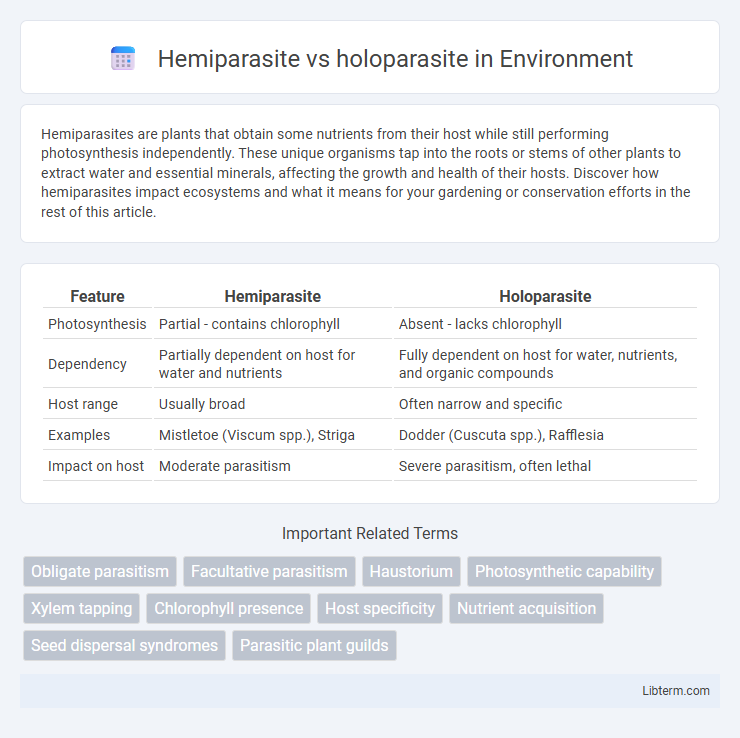Hemiparasites are plants that obtain some nutrients from their host while still performing photosynthesis independently. These unique organisms tap into the roots or stems of other plants to extract water and essential minerals, affecting the growth and health of their hosts. Discover how hemiparasites impact ecosystems and what it means for your gardening or conservation efforts in the rest of this article.
Table of Comparison
| Feature | Hemiparasite | Holoparasite |
|---|---|---|
| Photosynthesis | Partial - contains chlorophyll | Absent - lacks chlorophyll |
| Dependency | Partially dependent on host for water and nutrients | Fully dependent on host for water, nutrients, and organic compounds |
| Host range | Usually broad | Often narrow and specific |
| Examples | Mistletoe (Viscum spp.), Striga | Dodder (Cuscuta spp.), Rafflesia |
| Impact on host | Moderate parasitism | Severe parasitism, often lethal |
Introduction to Plant Parasitism
Plant parasitism involves species that derive nutrients from host plants, with hemiparasites partially depending on their hosts while retaining photosynthetic ability. Hemiparasitic plants, such as mistletoes, extract water and minerals but synthesize their own carbohydrates through photosynthesis. In contrast, holoparasites like dodder lack chlorophyll entirely and rely entirely on hosts for water, minerals, and organic compounds, demonstrating a full parasitic dependency.
Defining Hemiparasites
Hemiparasites are plants that perform photosynthesis while extracting water and nutrients from host plants through specialized structures called haustoria. Unlike holoparasites, hemiparasites contain chlorophyll and can produce their own food but rely on hosts for essential resources. Common examples include mistletoe and certain species of broomrape, which exhibit partial parasitic behavior.
Defining Holoparasites
Holoparasites are fully parasitic plants that lack chlorophyll and depend entirely on their host for water, nutrients, and organic compounds, as seen in species like Rafflesia and dodder (Cuscuta). Unlike hemiparasites, which perform photosynthesis and partially rely on their host, holoparasites have lost the ability to photosynthesize and exhibit highly specialized structures such as haustoria to extract resources. Their complete dependence on host plants for survival defines their ecological and physiological strategies, impacting host-parasite interactions significantly.
Key Differences Between Hemiparasites and Holoparasites
Hemiparasites possess chlorophyll and can perform photosynthesis, relying partially on their host plants for water and nutrients, whereas holoparasites lack chlorophyll and depend entirely on their hosts for all nutrients and energy. Hemiparasites typically attach to the xylem of the host, extracting water and minerals, while holoparasites connect to both xylem and phloem, obtaining organic compounds and nutrients. The ecological impact of hemiparasites is often less severe compared to holoparasites, which can cause significant damage or even death to their host plants due to complete nutrient dependence.
Photosynthetic Capabilities Compared
Hemiparasites possess partial photosynthetic capabilities, enabling them to generate some of their own energy through chlorophyll-containing leaves while extracting water and nutrients from host plants. In contrast, holoparasites lack chlorophyll entirely and rely completely on their hosts for organic compounds and energy, making them obligate parasites. This fundamental difference impacts their ecological roles and physiological adaptations within parasitic plant species.
Host Interaction Mechanisms
Hemiparasites interact with their hosts by photosynthesizing independently while extracting water and nutrients through haustoria, maintaining partial autotrophy. Holoparasites lack chlorophyll and depend entirely on host plants for all nutrients and water, using specialized haustoria to penetrate host vascular tissues. The differing host interaction mechanisms reflect hemiparasites' dual strategy of self-reliance and parasitism versus holoparasites' complete dependence on host resources.
Examples of Hemiparasitic Plants
Hemiparasitic plants, such as mistletoe (Viscum album), Indian paintbrush (Castilleja spp.), and yellow rattle (Rhinanthus minor), partially rely on their hosts for water and nutrients while retaining the ability to photosynthesize. Unlike holoparasites that lack chlorophyll entirely, hemiparasites possess green leaves and perform photosynthesis to supplement their nutritional needs. These plants typically attach to host roots or stems, extracting water and minerals without fully depending on the host for organic compounds.
Examples of Holoparasitic Plants
Holoparasitic plants, such as *Rafflesia arnoldii*, *Cuscuta* species, and *Balanophora*, completely depend on their host plants for water, nutrients, and photosynthates, lacking chlorophyll and the ability to photosynthesize. These plants exhibit highly specialized adaptations, including haustoria that penetrate host tissues to extract resources directly. Notably, *Rafflesia arnoldii* produces the largest flower among parasitic plants, highlighting the extreme specialization found in holoparasites.
Ecological and Evolutionary Roles
Hemiparasites, capable of photosynthesis, often influence ecosystem dynamics by partially extracting water and nutrients from host plants while contributing to overall biodiversity and nutrient cycling. Holoparasites, lacking chlorophyll and fully dependent on their hosts for survival, drive evolutionary pressures leading to host specialization and coevolution, impacting plant community structures. Both parasitic strategies shape ecological interactions and evolutionary trajectories by altering resource allocation, host fitness, and species diversity in their habitats.
Significance in Agriculture and Ecosystems
Hemiparasites, such as mistletoe, perform photosynthesis but extract water and nutrients from host plants, influencing ecosystem nutrient cycling and promoting biodiversity by creating microhabitats. Holoparasites, including dodder, lack photosynthetic ability and rely entirely on hosts for nutrients, often causing significant yield losses in crops and leading to economic challenges in agriculture. Understanding the ecological roles and impacts of these parasitic plants is crucial for managing their effects on crop health and maintaining ecosystem stability.
Hemiparasite Infographic

 libterm.com
libterm.com